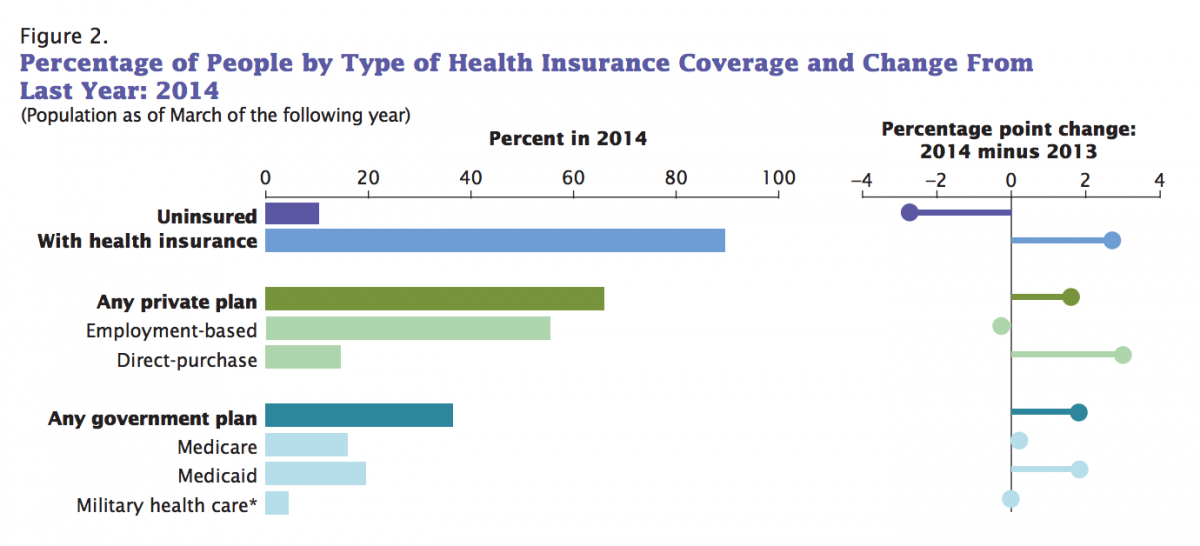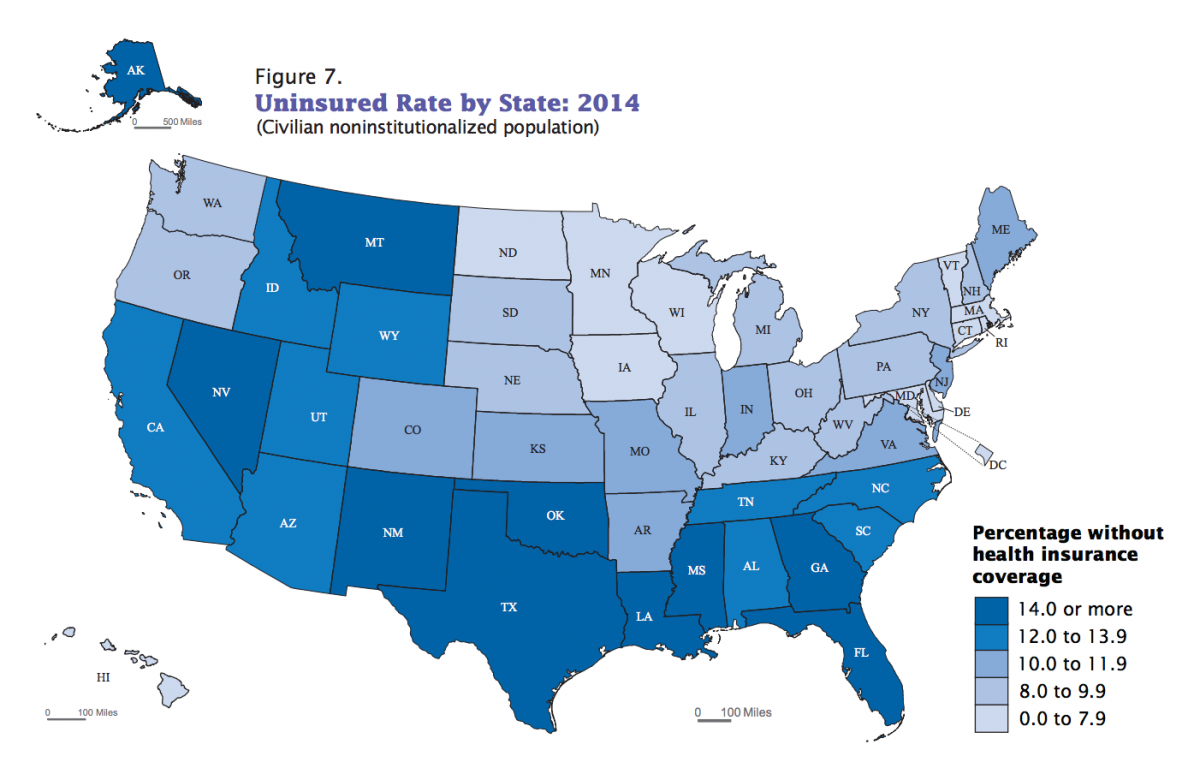Census confirms rate of uninsured dropped post-Obamacare; Medicaid expansion states fared better
The rate of those getting private insurance increased by 1.8 percent.

More Americans are getting health insurance either through private or government plans than they were in 2013, according to U.S. Census figures for 2014 released Wednesday that points to the Affordable Care Act as a major driver for the change.
This follows several years of a relatively stable uninsured rate between 2008 and 2013, according to the Census Bureau.
All 50 states and the District of Columbia showed a decrease in the percentage of people without health insurance coverage: from 10.4 percent in 2014 versus 13.3 percent in 2013.
While the increase in coverage could be attributed to rates, demographics or policy changes, Census authorities credit the latter, saying many of the provisions of the Affordable Care Act went into effect in 2014.
The ACA focused on covering working Americans ages 19 to 64 years old, a group that showed a decline in the number with insurance the previous year, according to Jennifer Cheeseman Day, assistant division chief for Employment Characteristics, Social, Economic and Housing Statistics Division.

"That is where many of the provisions of the ACA were focused, on that age group," she said.
The percent of people with health insurance for all or part of 2014 was 89.6 percent, higher than the rate of 86.7 percent in 2013.
The rate of those getting private insurance increased by 1.8 percent, to 66 percent, from 2013 to 2014, and the rate of government coverage increased by 2 percent to 36.5 percent, according to Census figures.
Employment-based insurance covered 55.4 percent of the population followed by Medicaid at 19.5 percent, Medicare at 16 percent, direct purchase at 14.6 percent and military healthcare at 4.5 percent.
Between 2013 and 2014, the greatest increases in coverage rates were for direct-purchase health insurance and Medicaid, according to the Census figures.
The largest change was coverage for direct-purchase, which increased by 3.2 percent, while the percentage of those with Medicaid coverage increased by 2 percent.

The state with the lowest percent of the population without health insurance in 2014 was Massachusetts, at 3.3 percent, while the highest uninsured rate was in Texas, at 19.1 percent.
By region, the south and west showed a greater percent of residents without insurance.
California, Nevada, Idaho, Montana, Wyoming, Utah, Arizona, New Mexico, Texas, Oklahoma, Louisiana, Mississippi, Alabama, Tennessee, Georgia, Florida, North Carolina, South Carolina and Alaska had a rate of uninsured at 12 percent of higher.
States with the lowest percent of uninsured are Vermont, Massachusetts, Connecticut, Delaware, Maryland, District of Columbia, Hawaii, Minnesota, Wisconsin, Iowa, and North Dakota, which have rates of uninsured at less than 8 percent.
The biggest decreases in the rate of those uninsured from 2013 to 2014 were in western states, with Washington, Oregon, Nevada, California, Arizona, Colorado, and New Mexico reporting a 3.5 percent or greater decrease in the numbers of uninsured.
Other states which decreased their rate of uninsured by 3.5 percent or more included Arkansas, Kentucky, West Virginia and Rhode Island.

The Census figures showed that of 24 states and District of Columbia that expanded Medicaid, only four had rates of uninsured of 14 percent or more, compared to 15 of the 26 non-expansion states.
By age, those in their 20s were the most likely to be uninsured, both in 2013 and 2014, though the rate decreases across that decade from one year to the next.
For 26-year-olds in 2013, 30.6 percent -- representing the highest percentage of any age -- were uninsured, compared to 25.1 percent of 30-year-olds in 2014.
The uninsured rate by work experience, ages 18 to 64 years old, shows that those who worked full time, year-round, are less likely to be uninsured than those who work less than full time and non-workers.
For 2014, 11.2 percent of full-time workers were uninsured, compared to 17.7 percent of those who worked less than full time and 17.3 percent of non-workers. All three groups showed decreases in the number of uninsured from the year before.
Household income also plays a part, with the uninsured rate dropping as incomes rise, from 16.6 percent for households making less than $25,000 to 5.3 percent to those making $100,000 or more.
By race, 19.9 percent of Hispanics reported being uninsured in 2014, compared to 11.8 percent of African Americans; 9.3 percent of Asians; and 7.6 percent of Caucasians.
Those native born or naturalized showed uninsured rates of 8.7 and 10.2 percent, respectively, compared to non-citizens, a group that reported a 31.2 percent uninsured rate.
The U.S. Census Bureau released its findings Wednesday for income, poverty and health insurance coverage, along with supplemental poverty measures in 2014.
There was no significant change from 2013 in either real median household income or the official poverty rate, according to the figures.
The nation's official poverty rate in 2014 was 14.8 percent, which means there were 46.7 million people living in poverty.
Like Healthcare Finance on Facebook
This marks the fourth consecutive year in which the number of people in poverty was not statistically different from the previous year's estimate.
Median household income in the United States in 2014 was $53,657. This was the third consecutive year that the annual change was not significant, following two consecutive annual declines.
A comparison of real median household income over the past seven years shows that income is 6.5 percent lower than in 2007, the year before the most recent economic recession.
On Thursday, the Census Bureau will release single-year estimates of median household income, poverty and health insurance for all states, counties, places and other geographic units with populations of 65,000 or more from the 2014 American Community Survey.
These statistics will include social, economic and housing characteristics, such as language, education, commuting, employment, mortgage status and rent.
Twitter: @SusanMorseHFN












































